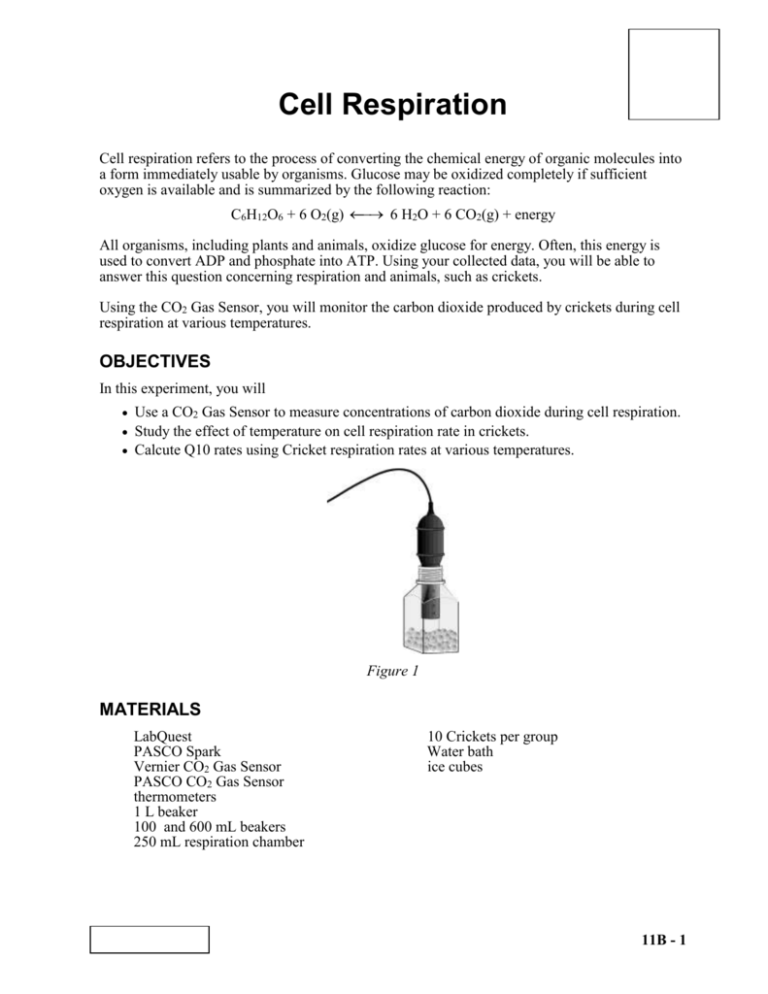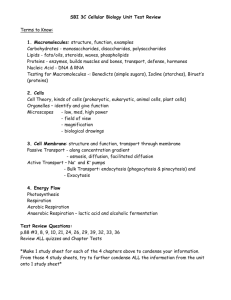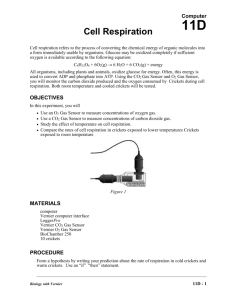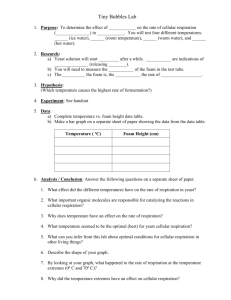2 day 17 Cellular Respiration with Animals (CO2) LQ
advertisement

LabQuest Cell Respiration 11B Cell respiration refers to the process of converting the chemical energy of organic molecules into a form immediately usable by organisms. Glucose may be oxidized completely if sufficient oxygen is available and is summarized by the following reaction: 6 H2O + 6 CO2(g) + energy C6H12O6 + 6 O2(g) All organisms, including plants and animals, oxidize glucose for energy. Often, this energy is used to convert ADP and phosphate into ATP. Using your collected data, you will be able to answer this question concerning respiration and animals, such as crickets. Using the CO2 Gas Sensor, you will monitor the carbon dioxide produced by crickets during cell respiration at various temperatures. OBJECTIVES In this experiment, you will Use a CO2 Gas Sensor to measure concentrations of carbon dioxide during cell respiration. Study the effect of temperature on cell respiration rate in crickets. Calcute Q10 rates using Cricket respiration rates at various temperatures. Figure 1 MATERIALS LabQuest PASCO Spark Vernier CO2 Gas Sensor PASCO CO2 Gas Sensor thermometers 1 L beaker 100 and 600 mL beakers 250 mL respiration chamber Biology with Vernier 10 Crickets per group Water bath ice cubes 11B - 1 LabQuest 11B PROCEDURE 1. If your sensor has a switch, set it to the Low (0–10,000 ppm) setting. Connect the CO2 Gas Sensor to the data collection device and choose New from the File menu. 2. Measure the room temperature using a thermometer and record the temperature in Table 1. 3. Obtain 10 crickets from your teacher. 4. Place the 10 crickets into the respiration chamber. 5. Place the shaft of the CO2 Gas Sensor in the opening of the respiration chamber. 6. Wait one minute, then start data collection. Data will be collected for 5 minutes. 7. When data collection has finished, a graph of carbon dioxide gas vs. time will be displayed. 8. Remove the CO2 Gas Sensor from the respiration chamber. Place the crickets in a 600 mL beaker. Be sure they do not escape while you prep for the next station. 9. Use a notebook or notepad to fan air across the openings in the probe shaft of the CO2 Gas Sensor for 1 minute. 10. Fill the respiration chamber with water and then empty it. Thoroughly dry the inside of the respiration chamber with a paper towel. 11. Draw the graph shown on your data collection device. 12. Repeat Steps 4–11 for each temperature you have been assigned. DATA Temperature ⁰C Respiration Rate (ppm/sec.) 5 - 15⁰ C 15- 25⁰ C 25 - 35⁰ C 35 - 45⁰ C 45- 55⁰ C QUESTIONS 1. Do you have evidence that cell respiration occurred in crickets? Explain. 2. What is the effect of colder temperatures on the rate of cell respiration in crickets? Explain. 3. What is the effect of warmer temperature on the rate of cell respiration in crickets? Explain. 11B - 2 Biology with Vernier Cell Respiration 4. Predict what would happen to your respiration in colder temperatures? Explain. 5. Predict what would happen to your respiration in warmer temperatures? Explain. INDEPENDENT VARIABLE (X axis): _________________________________________ DEPENDENT VARIABLE (Y axis): ___________________________________________ CALCUTATING Q10 The Q10 temperature coefficient is a measure of the rate of change of a biological or chemical system as a consequence of increasing the temperature by 10 °C. There are many examples where the Q10 is used, one being the calculation of the nerve conduction velocity and another being calculating the contraction velocity of muscle fibres. It can also be applied to chemical reactions,such as enzymes, photosynthesis, or cellular respiration and many other systems. The Q10 is calculated as: where R2 is the rate of the higher temperature reaction; R1 is the lower temp. T is the temperature in Celsius degrees. T2 is higher temp; T1 is lower temp. Ideally, your power would be 1 or 10/10. Q10 is a unitless quantity, as it is the factor by which a rate changes, and is a useful way to express the temperature dependence of a process. For most biological systems, the Q10 value is ~ 2 to 3 1. What is the Q10 between (5 -15⁰C) and (15-25⁰C)? 2. What is the Q10 between (15-25⁰C) and (25-35⁰C)? 3. What is the Q10 between (25-35⁰C) and (35-45⁰C)? 4. What is the Q10 between (35-45⁰C) and (45-55⁰C)? 5. Do the Q10 values seem logical based on the statement above that for biological systems Q10 is a value between 2 and 3? Justify your answer. Biology with Vernier 11B - 3









